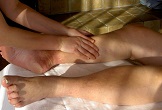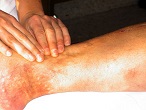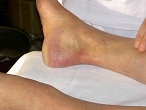Lymphatic Drainage – History and more
Lymphatic Drainage Therapy – what is it about?
Manual Lymphatic Drainage Massage – history
In the 1930s, E.Vodder, massage therapist from Denmark, was working on the Cote d’Azur in France. At that time many people suffering from chronic respiratory infections came to the health spas situated along the Cote d’Azur.
While treating a young patient suffering from nose and throat infections by applying slow, circling and pumping hand movements over the enlarged cervical lymph nodes, Vodder noted, that the complaints cleared up after a few treatments.
He asked himself “Is it possible to clear up congestions in the lymphatic vessels by a simple massage?”. E. Vodder widens his knowledge about the lymphatic system and its role in a wide range of healing processes. He developed a new technique of massage and held lectures, first only to beauticians. Among them was the wife of Dr. Asdonk, a german physician. She told her husband about the new technique.
Thereupon, Dr. Asdonk, became an associate of Vodders and learned this new kind of massage himself and applied it afterwards with great success in his clinic in St. Blasien, Germany.
Manual Lymphatic Drainage (MLD) was developed by Vodder and thanks to Dr. Asdonk, it was acknowledged as a therapy by medical science. Not least, thanks to the academic work on the lymphatic system by Dr. Földi.
The first clinic specializing in lymphological disorders was founded at St. Blasien by Dr. Asdonk followed by the establishment of the first school for MLD by Asdonk. Its three pillars are: Manual Lymphatic Drainage (MLD), Complex Decongesting Therapy (CDT), and gymnastic exercise while wearing the bandages.
In Germany the MLD is well known as a medical therapy, whereas in Switzerland it is most known as an beauty treatment.
However, its clinical relevance in treating water Retention in the tissue, lymph edemas, chronic ailments is becoming more and more acknowledged by conventional medical view as its pointed out by various lymphologists.
“The chronic lymphedema was once considered to be a relativlely benign condition of limb swelling associated with minimal morbidity. However, this old concept has been proven to be totally erroneous: the condition is steadily progressive and affects not only the lymphatic system itself, but also the entire surrounding soft tissue, resulting in a unique condition of clinically significant dermatolipofibrosclerosis “(Byung-Boong Lee et al. in: lymphedema, a concise compendium of theory and practice, London 2011.)
Manuelle Lymphdrainage- Therapie
Durch langsam Kreis-Bewegung mit dem Hautgewebe wird versucht, den Lymphabfluss – aus dem Bindegewebe in die Lymphbahnen- optimal anzuregen. Dadurch wird der Gewebestoffwechsel optimiert: das betroffene Gewebe wird besser mit Nährstoffen versorgt, Stoffwechselendprodukte werden besser abtransportiert.
Durch gezielt eingesetzte Ödemgriffe während der Therapie wird der Lymphfluss lokal intensiv angeregt und liegengebliebenes Eiweiss aus dem Bindegewebe entfernt. Dies führt normalerweise innerhalb von Tagen zu einer offensichtlichen Reduktion des Ödems sowie zu einem deutlich verbesserten Hautbild.
Gleichzeitig erfolgt eine unspezifische Anregung des Immunsystems, unspezifische Entzündungen werden reduziert.
Illustration von Ödemgriffen an einem Phlebolymphödem des Beins
Die Manuelle Lymphdrainage arbeitet im subkutanen Bindegewebe (nicht wie die Klassische Massage im Muskelgewebe). Dadurch wird eine zusätzliche Lymphbildung während der Therapie verhindert. Als Therapie eignet sie sich für eine Vielzahl von Beschwerdebildern des Bindegewebes und des Stoffwechsels.
Mögliche Nachwirkungen einer manuellen Lymphdrainage
Die manuelle Lymphdrainage aktiviert nachhaltig und tiefgreifend des Stoffwechsel. Da das Lymphgefässsystem den ganzen Körper durchzieht, kann die Therapie einer Extremität (Arm/Bein/Gesicht), Symptome im ganzen Körper zur Folge haben.
Durch die Stoffwechselaktivierung können nach einer Therapie folgende Symptome auftreten:
- Kopfschmerzen
- vermehrtes Wasserlassen
- vermehrter Durst
- Kribbeln in den Extremitäten
- erhöhte Müdigkeit
Diese Symptome sind Zeichen, dass der Stoffwechsel reagiert, die Lymphflüssigkeit zur Ausscheidung gebracht wird und der Gefässdurchfluss allgemein gesteigert wird. Sie mögen im Moment als unangenehm empfunden werden, sind jedoch positiv zu werten.
Genügend Wasser trinken und dem Körper die nötige Entspannung zukommen lassen, hilft dem Körper bei der Regeneration.





